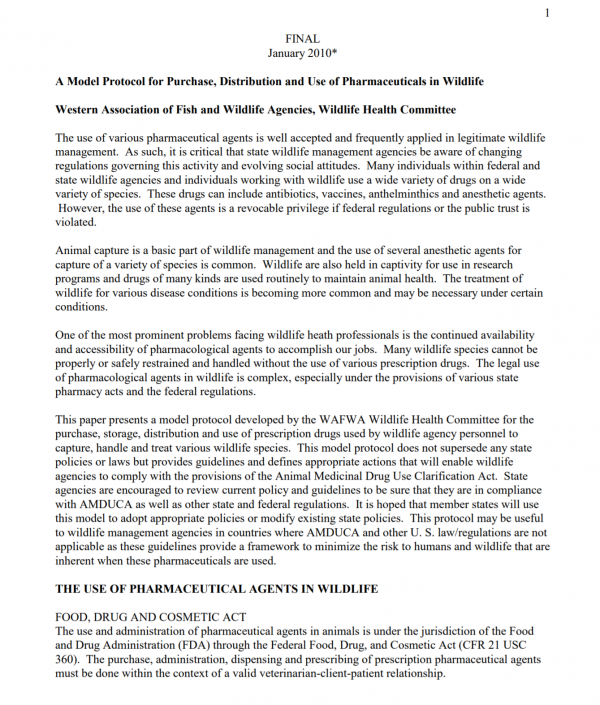The use of various pharmaceutical agents is well accepted and frequently applied in legitimate wildlife management. As such, it is critical that state wildlife management agencies be aware of changing regulations governing this activity and evolving social attitudes. Many individuals within federal and state wildlife agencies and individuals working with wildlife use a wide variety of drugs on a wide variety of species. These drugs can include antibiotics, vaccines, anthelminthics and anesthetic agents. However, the use of these agents is a revocable privilege if federal regulations or the public trust is violated.
Animal capture is a basic part of wildlife management and the use of several anesthetic agents for capture of a variety of species is common. Wildlife are also held in captivity for use in research programs and drugs of many kinds are used routinely to maintain animal health. The treatment of wildlife for various disease conditions is becoming more common and may be necessary under certain conditions. One of the most prominent problems facing wildlife heath professionals is the continued availability and accessibility of pharmacological agents to accomplish our jobs. Many wildlife species cannot be properly or safely restrained and handled without the use of various prescription drugs. The legal use of pharmacological agents in wildlife is complex, especially under the provisions of various state pharmacy acts and the federal regulations.
This paper presents a model protocol developed by the WAFWA Wildlife Health Committee for the purchase, storage, distribution and use of prescription drugs used by wildlife agency personnel to capture, handle and treat various wildlife species. This model protocol does not supersede any state policies or laws but provides guidelines and defines appropriate actions that will enable wildlife agencies to comply with the provisions of the Animal Medicinal Drug Use Clarification Act. State agencies are encouraged to review current policy and guidelines to be sure that they are in compliance with AMDUCA as well as other state and federal regulations. It is hoped that member states will use this model to adopt appropriate policies or modify existing state policies. This protocol may be useful to wildlife management agencies in countries where AMDUCA and other U. S. law/regulations are not applicable as these guidelines provide a framework to minimize the risk to humans and wildlife that are inherent when these pharmaceuticals are used.
A product of the WAFWA Wildlife Health Committee.
Attached Files
| File | Action |
|---|---|
| WWHCDrugPrtc2010.pdf | Download |
- Version
- File Type pdf
- File Size 119.42 KB
- Publication Date January 6, 2010
